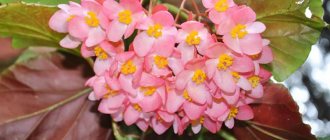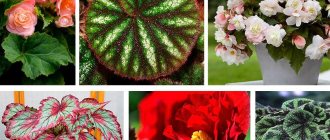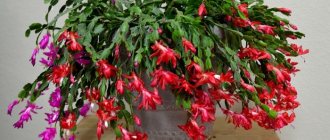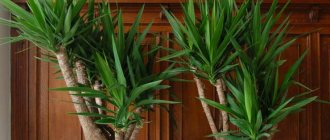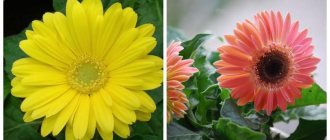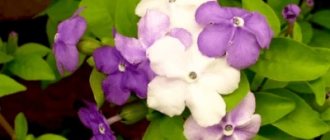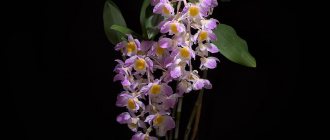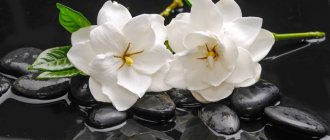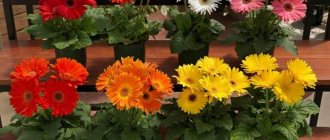Nertera is an exotic tropical plant that appeared in our area and became popular among gardeners quite recently. A distinctive feature of this plant is the berries with which the green bush is strewn, like a Christmas tree with decorations for the New Year. They can be white, yellow, orange and red, depending on the variety. In this article we will introduce you to all the nuances of caring for nertera at home.
Description
Nertera (lat. Nertera) is a genus of flowering plants in the Rubiaceae family. It is small and includes no more than 12 species of ground cover plants. The name comes from the Greek word “nerteros”, which means low, small.
For the most part, plants belonging to this genus are found in the tropical and subtropical areas of southeast Asia and the Australian continent. This representative is cultivated quite well in greenhouses and apartments, but this mainly concerns Nertera Granada.
It is no coincidence that the genus received its name. Neteru can be translated from Greek as “small”. Miniature size is a distinctive feature of representatives belonging to this genus. The plant has other names. It is often referred to as “coral berry” or “coral moss.” Of course, these names are unofficial. But they contain another feature of these representatives - a large number of small berries (plant fruits) with a rich, bright color. They are scattered all over, like beads.
Uses of coral moss
According to bioenergeticists, coral moss or Nertera gives vitality to a person, strengthens the body, increases endurance, and increases activity. That’s why it wouldn’t hurt to get an unusual plant at home.
In floristry, coral moss is used to create flower arrangements, decorate flower beds in greenhouses, and create miniature landscapes. A miniature, ornamental, fruit-bearing plant, it fits well into indoor flower arrangements, decorating them with its appearance and delighting the owners.
Nertera is truly a rarity, because not everyone can follow all the rules of care, but those who strictly follow the recommendations can easily not only raise a beauty, but also successfully reproduce it.
Join our Facebook group
Appearance
The stem of the plant can be compared to a miniature vine. But its length is insignificant and does not exceed 2 cm. The stems line the surface, forming a miniature mat. The small leaves have a round, slightly elongated shape. The appearance of the flowers is inexpressive, with a predominant green-white hue of the color palette. The fruits are pea-sized with bright orange, red or brown berries. When the nertera bush bears fruit, it can be compared to cranberries or lingonberries. The fruiting period occurs in winter, which inspires the owner with a certain optimism and pleases with its beauty.
Important! The fruits of the plant cannot be eaten, due to their toxicity, although the temptation to pick the berries and eat them is present.
Most often, nertera is grown for only one season, because it is difficult to provide this flower with a proper rest period in the conditions of our apartments. And without a good winter sleep, the nertera will no longer have its former attractiveness. She will simply become unattractive in appearance. But if you show it proper care, attention and care, it will delight its owner for several years in a row.
This may be interesting: Yucca - reproduction, diseases and pests
Nertera balfouriana
Nerthera Balfour is a low-growing plant. It differs from other species by long stems with green rounded leaves. This species has white, small, star-shaped flowers. When ripe, the berries are orange and droplet shaped.
Drop shaped berry
In nature, the nertera flower grows for several years. In culture – cultivated as an annual plant.
Types and varieties
The genus includes various species, among which the following, most popular, representatives can be noted.
Pinned down
The plant grows in South America. It was there that it was first discovered. The leaves of this representative are distinguished by their small round shape and bright green color. During flowering, small white-green flowers bloom profusely, in place of which orange berries are formed after flowering. With good care, the diameter of the bush can reach 40 cm.
Grenada or Granadensis (Granadensis)
This type is no less popular. Nerthera grenada is found in Mexico. The diameter of the plant can reach 50 cm. The length of small leaves does not exceed 8 mm. Flowers with yellow-green tints. Subsequently, the appearance of bright orange berries can be observed on the plant.
Balfouriana
Balfour's nertera grows in New Zealand, where it is predominantly found in wetlands. It differs from other representatives of the Balfour genus in its larger berries, which have a pronounced rich orange color. The shape of the berries is similar to a pear.
Ciliata
Ciliated nertera flower
The ciliated nertera is also native to New Zealand. Differs from the previous type in a slightly smaller size. Its diameter rarely exceeds 25 cm. The fruits are fleshy orange or red. The leaves are equipped with small cilia.
Cunninghamii
Compared to other representatives of this genus, it is small in size. Rarely does its diameter exceed 20 cm. The color of the berries has distinct bright red tones.
Caring for nertera at home
Caring for the nertera is not difficult, since it is quite unpretentious. But, nevertheless, all care activities must be carried out competently. Only in this case will the coral berry delight the owner with its appearance.
Lighting requirements
The plant loves light, but we do not recommend placing it in direct sunlight. Nertera should be placed in a place with diffused light (there should be curtains or blinds on the windows). In winter, nertera loses its attractiveness due to lack of light, so it must be periodically illuminated with a fluorescent lamp. But the lamp should not be placed too close. The light source must be no closer than 60 cm, otherwise the plant will get burned.
Temperature
In spring and summer, the room temperature should be 20-22 degrees. From October to March, the nertera needs a period of rest. At this time, the temperature should be gradually reduced to 10-12 degrees. Nertera loves fresh air, so if you want to get a healthy flowering bush next season, regularly ventilate the room where your beauty winters. With the onset of spring, when the air temperature outside is about 8-10 degrees, place the flower on the balcony. There he will feel more comfortable. But the plant must be placed in such a way as to avoid drafts and direct sunlight. As soon as the ovaries appear on the plant, bring it back indoors.
Watering and air humidity
Watering should be done as the soil dries out. There is no need to be too zealous, otherwise the roots may rot. But when there is active plant growth, abundant watering is necessary. In addition, it is recommended to spray warm water over the surface of the plant using a spray bottle.
During dormancy, watering the coral berry is reduced. Nertera does not require much moisture during this period, since the plant’s metabolism is slow.
If the air in the room is too dry, you can correct the conditions by placing wet expanded clay in the tray of the pot. It additionally moistens the soil.
This may be interesting: Methods for propagating croton at home
Fertilizers and fertilizers
Nertera does not need frequent feeding. It should be fed only during the growing season. Practice shows that as soon as fertilizing is carried out, coral moss immediately enters an active growth phase. Therefore, use fertilizers if you want your bush to become fluffier.
It is recommended to use complex mineral fertilizers for fertilizing. Application to the soil is carried out monthly throughout the entire growth period.
Watering rules
When caring for a plant at home, you should provide it with proper watering. In the spring and summer months, the plant should be watered abundantly. With the onset of cold weather and in winter, watering is gradually reduced. It is not recommended to water the plant from above; you need to pour water into a tray or take a bowl with a volume larger than the pot, collect water and place the nertera there.
In order to achieve the highest degree of decorativeness of the plant, you should always keep the soil moist and select only that which has looseness and the ability to retain moisture. During the growth of the plant, the soil is fertilized with a complex of minerals approximately once a month.
Rules for planting and transplanting
The best time to transplant a plant is the beginning of spring, before the flowering period. If you replant the nertera when it has already bloomed, then it will certainly drop all its flowers, and you will be left without berries for a whole year. Transplantation is carried out into a larger pot as it grows. The pot should be shallow but wide, since the roots of the plant do not have the habit of growing very deep.
Certain requirements are also imposed on the soil. It should be light and loose. In order for a flower to grow actively, the soil must contain a full set of mineral elements. The best option is a composition containing turf, humus and leaf soil. All components must be present in equal parts. Be sure to add sand and peat. The best way is to purchase a ready-made composition in a specialized store. Plain soil from the street is not suitable for planting.
Reproduction of nertera
Nertera is propagated by seeds, cuttings and by dividing the root. Let's talk about each of the methods.
Growing from seeds
Sowing time occurs at the end of January - beginning of February. To plant seeds, use a wide container filled with soil. There should be a drainage layer at the bottom. When sowing, one important condition must be observed - the seeds should not be placed too close to each other. The seed should be sprinkled with earth and compacted a little. A board is used for this. After sowing, the soil must be irrigated with water from a spray bottle. After this, the container is covered with any translucent material and sent to a warm place. The material for covering the container should not allow air to pass through.
The seeds will germinate unevenly. The appearance of the first shoots can be seen only after a month. Sometimes this takes 2 or even 3 months. When the seedlings appear in quite a large number, the container is transferred to a warm and bright place. Remember the “direct sunlight” rule. If the lighting is insufficient, the seedlings should be illuminated. The frequency of watering depends on the rate of drying of the top layer of soil.
Propagation by dividing rhizomes
Nertera can also be propagated by dividing the rhizome. It is better to do this at the end of summer, when the first berries begin to fall off.
- The plant is removed from the pot.
- The rhizome is freed from the ground.
- The root ball is divided into several not too small parts. If the parts are very small, the plant will bear little fruit.
- The resulting parts are planted in pre-prepared separate pots, which already have drainage and fresh soil mixture.
- Pots with planting material are placed in a cool place. This is necessary for good rooting of the plant. Once the plant is established, it will resume growth.
This may be interesting: Formation of the appearance of Ficus Benjamin
Propagation by cuttings
Coral berry also reproduces well by cuttings. To do this, it is enough to place the cutting 2/3 of its length in water and wait for the roots to appear. To speed up the process, you can add root or any other root formation stimulator to the water. The first roots will appear in a couple of weeks. Wait until their length is about 1 cm and plant the cuttings in a pot with soil. Next, continue to care for the cutting as if it were an adult plant.
Diseases and pests
Various care errors lead to diseases of indoor plants. Nertera is no exception, and can become ill if the owner does not care for it properly. Now we will describe the most common symptoms of diseases and teach you how to determine the diagnosis.
- If the nertera does not bloom and there are no fruits on it, but at the same time new leaves and shoots appear on the plant en masse, then your specimen is very hot and there is not enough moisture in the air. Move the pot to a cooler room and spray it periodically with a spray bottle.
- The shoots rot at the point of contact with the soil. Chances are you are over-watering your coral berry. Check the soil and if it is wet, stop watering the plant for 7-10 days. After this period, begin to water the nertera moderately according to all the watering rules.
- The tips of the shoots and leaves turn brown and die. Most likely, this is due to the soil in the pot drying out or getting burned due to direct sunlight. Move the pot to a more shaded place and water thoroughly.
- Shriveled berries. It seems that you were unable to provide a comfortable low temperature during the resting period of the nertera. There's nothing that can be done this season. Remember your mistakes and try not to make them in the future.
Various insect pests do not bypass the flower either. This could be aphids, whiteflies, scale insects, mealybugs, spider mites. Carefully cover the flower with a plastic bag so that none of the insects get on neighboring plants and escape. Then spray the nertera under the bag with an insecticide and leave it to stand for half an hour. After the time has passed, take the pot to the balcony, remove the bag and ventilate for 5 minutes.
Difficulties in growing
- The absence of flowers (berries) and their falling off when a large amount of leaf mass develops - high air temperature; high nitrogen content in the soil as a result of excessive fertilization.
- Rotting of the bases of the stems - excessive watering.
- Drying leaf tips - insufficient watering or excessive lighting.
- When leaves acquire a brown tint, this indicates an excess of light and heat.
- Wrinkling of berries - too warm winter conditions.
Nertera is most often attacked by spider mites, mealybugs, scale insects and whiteflies.
